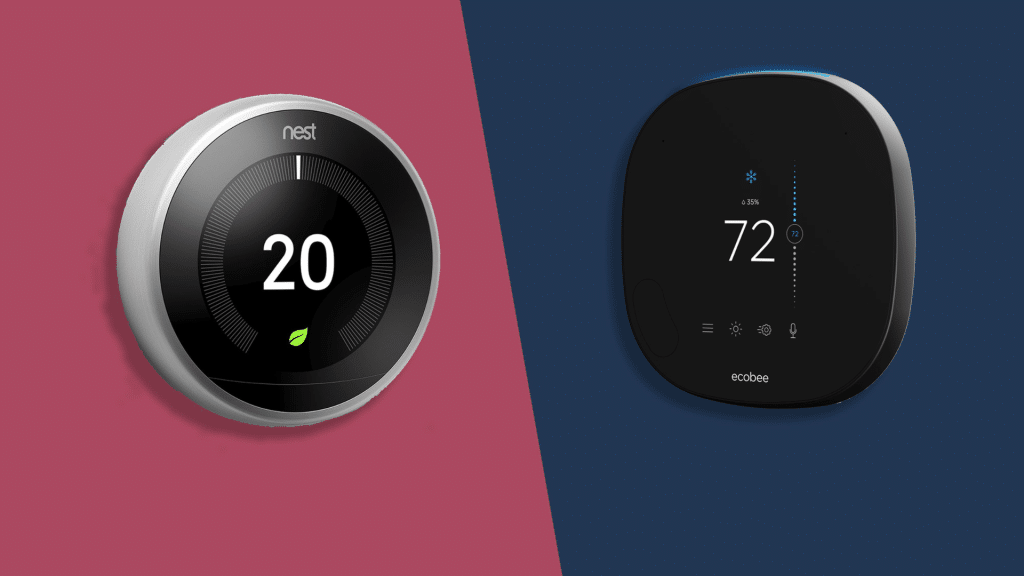When I first looked into smart thermostats, the main question was clear: Google Nest vs Ecobee, which one actually fits my home better?
Both promise comfort, energy savings, and smarter temperature control, but they work in very different ways.
In this post, I’ll walk you through how they compare in design, features, and performance so you can decide which one is right for your space.
Google Nest vs Ecobee: Brief Overview
Both Google Nest and Ecobee are top choices for smart home comfort. They help you control temperature automatically and reduce energy use without constant manual adjustments.
Nest focuses on a simple, hands-off experience. It learns your habits and creates a schedule that adjusts itself over time.
Ecobee gives you more control with detailed settings and room sensors that track both temperature and motion.
If you prefer automation and ease, Nest might fit your style. If you want precision and more data, Ecobee could be the better match.
Design and Display
Both thermostats have unique designs that fit different user preferences. Here’s how they compare in style, display, and ease of use.
1. Shape and Style
The Google Nest thermostat has a clean, circular design with a smooth glass finish. Its ring dial lets you adjust the temperature easily, and it blends well with most home styles.
The Ecobee thermostat features a rectangular body with rounded edges and a large color touchscreen. It feels more like a smart display, ideal for users who want information up front.
2. Display Features
Nest’s display lights up automatically when you walk by, showing the temperature, time, or weather. Its bright, motion-activated screen makes it feel both smart and minimal.
Ecobee’s touchscreen shows everything directly – current temperature, humidity, mode, and voice controls. It’s great for users who prefer a hands-on view of their home’s comfort.
3. Ease of Use
Nest is built for users who prefer simplicity. Once it learns your schedule, it handles most adjustments automatically, making it a true “set it and forget it” device.
Ecobee gives you manual control and feedback. You can view reports, tweak comfort levels, or switch modes right from the screen or app. It suits users who like precise control.
In short, Nest wins for design and ease, while Ecobee stands out for control and data visibility.
Google Nest vs Ecobee: Smart Features and Automation
Both Google Nest and Ecobee offer powerful smart features that make heating and cooling effortless. The main difference lies in how much automation or control you prefer.
| Feature | Google Nest | Ecobee |
|---|---|---|
| Learning System | Uses AI learning to create automatic schedules based on your habits | Offers manual scheduling with full control over time and temperature |
| Room Sensors | Works with optional sensors (temperature only) | Comes with SmartSensors that track temperature and motion |
| Automation | Adjusts automatically between Eco and Comfort modes | Allows custom routines and detailed comfort settings |
| Smart Integration | Best with Google Home and Assistant; supports Alexa | Works with Apple HomeKit, Alexa, Google Assistant, and SmartThings |
| Energy Insights | Provides basic energy reports in the Google Home app | Gives detailed energy data and saving suggestions in its app |
| Control Style | Hands-off automation once setup is complete | Hands-on customization for precise temperature control |
This breakdown shows that Nest focuses on automation, while Ecobee emphasizes control and detailed insights, giving users the freedom to choose what fits their comfort style best.
Energy Efficiency and Savings
Both Google Nest and Ecobee are designed to cut energy costs by managing heating and cooling efficiently. The main difference lies in how they balance automation and control.
Google Nest
- Learning Mode: Adapts to your daily routine and temperature preferences.
- Eco Mode: Automatically reduces heating or cooling when you’re away.
- Hands-Off Operation: Runs quietly in the background with minimal setup.
- Energy Reports: Simple summaries available in the Google Home app.
- Efficiency: Typically saves about 10–15% on energy bills each year.
Ecobee
- SmartSensors: Detects occupancy and adjusts room temperatures accurately.
- Custom Schedules: Let you fine-tune comfort for each day and time.
- Detailed Insights: Tracks energy use and provides personalized tips in the app.
- Voice and App Control: Compatible with Alexa, Siri, and Google Assistant.
- Efficiency: Users report up to 23% annual savings with smart scheduling.
Both thermostats make your home more efficient – Nest focuses on learning your habits, while Ecobee gives you precise control and deeper energy insights
Installation and Compatibility

Installation:
Both thermostats are easy to install, but Nest focuses on a quick DIY setup, while Ecobee offers more flexibility for complex systems.
- Nest: Works without a C-wire in most homes, making it perfect for quick self-installation. The Google Home app walks you through each step and finishes setup in minutes.
- Ecobee: Usually needs a C-wire but includes a power extender kit for older HVAC systems. Setup takes longer but remains beginner-friendly with a clear touchscreen and app guidance
Smart Home Integration:
Nest works best within Google’s ecosystem, integrating smoothly with Google Home and Assistant, plus support for Alexa.
Ecobee offers broader compatibility, connecting with Apple HomeKit, Alexa, Google Assistant, and SmartThings—ideal for users with mixed smart devices.
Connectivity and Control:
Both models use Wi-Fi for remote access and app-based control. You can adjust temperature, check energy use, or switch modes from anywhere using your phone.
Nest is easier to install and a better fit for Google Home users who want simple automation. Ecobee takes a bit more setup but delivers wider smart home compatibility and deeper customization options
User Experience
Both Google Nest and Ecobee have earned loyal users, but feedback shows differences in reliability, control, and compatibility.
Nest
TechMike87, Reddit – “Nest setup was fast and easy, but it sometimes disconnects from Wi-Fi after updates.”
HomeGuru21, SmartHomeTalk – “Love how Nest learns my schedule automatically. I barely touch it anymore.”
LauraS_89, Google Community – “Great design and smart features, but the app can be slow to sync at times.”
Ecobee
JasonR_HomeFix, MacRumors – “Ecobee gives me more control over each room with the sensors—works great with HomeKit.”
KellyTowns, SmartThings Forum – “It took longer to install than I expected, but the energy reports are super detailed.”
Rafael_M, Reddit – “Voice control and schedules are reliable. A bit geeky to set up, but totally worth it once running.”
Both earn praise – Nest for ease and automation, Ecobee for flexibility and deeper insights.
Smart Home Integration & Voice Control
Nest connects smoothly with Google Assistant and also works with Alexa, making it ideal for homes already using Google smart speakers and displays.
Ecobee supports Apple HomeKit, Alexa, Google Assistant, and SmartThings, offering broader compatibility for mixed-platform homes. It also includes a built-in Alexa speaker, allowing users to control other smart devices directly.
Both respond to voice commands like “set temperature to 72 degrees,” letting you make quick changes without opening the app.
Ecobee simply adds more flexibility for users who like hands-on smart home control.
Google Nest vs Ecobee: Price and Model Comparison
Both Google Nest and Ecobee have different models designed for varying budgets and needs.
| Model | Key Features | Approx. Price Range | Best For |
|---|---|---|---|
| Google Nest Thermostat | Basic scheduling, app control, Eco mode | Lower price tier | Budget users who want simple automation |
| Google Nest Learning Thermostat | AI learning, motion sensors, premium metal design | Mid to high tier | Users who want advanced automation and a sleek design |
| Ecobee Smart Thermostat Premium | SmartSensors, built-in Alexa, air quality monitor | High tier | Users who want full control and data insights |
| Ecobee Smart Thermostat Essential | Scheduling, app control, SmartSensor support | Mid tier | Users seeking value and solid smart features |
If you prefer a simple setup and clean design, Nest offers great value. For deeper control, energy reports, and multi-room sensing, Ecobee delivers more features for the price.
Which Thermostat Should You Choose?
Both Google Nest and Ecobee deliver smart temperature control, but the right pick depends on your lifestyle and how much control you want.
Choose Google Nest If You’re
- A busy homeowner who wants heating and cooling to manage itself.
- A Google Home user with smart speakers or displays already in place.
- Someone who values simplicity and prefers minimal setup or manual input.
- A frequent traveler who wants the thermostat to switch to Eco mode automatically.
- An efficiency-first user who wants savings without constant adjustments
Choose Ecobee If You’re
- A smart home enthusiast using multiple platforms like Apple, Google, or Alexa.
- A hands-on user who likes adjusting schedules and fine-tuning settings.
- A data-focused homeowner who wants detailed energy reports and room insights.
- A family user needing even comfort across multiple rooms through SmartSensors.
- Someone who likes voice control since Ecobee has Alexa built right in.
In short, Nest is the smarter choice for automation and simplicity, while Ecobee wins for customization, compatibility, and precision.
Conclusion
The Google Nest vs Ecobee debate comes down to what matters most to you: ease or control. Both thermostats save energy and make managing your home simpler.
If you want automation that learns your habits, Google Nest is the smarter fit. If you prefer control, data insights, and flexibility, Ecobee delivers more features for the price.
When comparing the Ecobee vs Nest thermostat, think about your routine and smart home setup.
Choose your thermostat today and start enjoying comfort, savings, and smarter control year-round.







